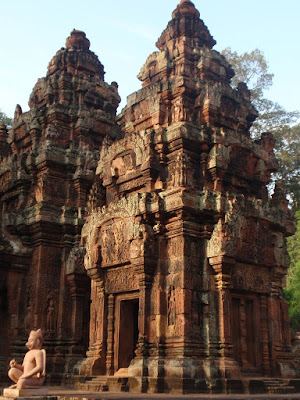Baphuon temple undergoing some serious reconstruction
As we made our way through the green tarps at Angkor
to the extremely loud construction taking place at Ta Prohm, I wondered to myself why the park had decided to undertake such huge projects independently of one another and why they were seemingly fixing all of the most famous temples at the same time. Wouldn’t it be nicer for the tourists if only one sight was besieged by jack hammers at a time?
numbered blocks at Ta Prohm
But the reason for this becomes apparent when you realize that each project is being funded different countries. The list of benefactors ranged from France to Japan, to UNESCO. Of course the people at Angkor aren’t going to look a gift horse in the mouth “um thank you for donating hundreds of thousands of dollars for Angkor’s restoration – can we take a rain check until 2015.”
rubble at Ta Prohm
We pressed on and managed to see some pretty great stuff that first day. After Bayon, our first stop was the Terrace of the Elephants and the Terrace of the Leper King, both of which we really enjoyed.
Terrace of the Elephants
The Terrace of the Leper King is a pair of walls - and outter and inner one - that are covered in carved figures Claire and Neil checking out the inner wall at the Terrace of the Leper King
Figures carved on the Terrace of the Leper King
Unfortunately, it’s popularity hasn’t been good for it and not only is it currently the sight of massive reconstruction, but the wooden walkways and photo-op platforms that have been placed throughout it have turned it into a bit of a circus and robbed it of the mystery and intrigue I’m sure it once held.
But it's definitely still a pretty neat temple to see.
Although I was a bit bummed by all of the work going on at Ta Prohm, I really enjoyed checking out the much less visited –and much quieter - Preah Khan.
I've got my hand on a linga to remind me what I cannot do...
some trees over taking the temple at Preah Khan
We finished our day with sunset at Angkor Wat on our way into Angkor wat for the first time
Angkor Wat basking in the late afternoon glow
an Angkorian windowsill
Nick checking out the sunset from Angkor Wat
A couple of days later, Nick and I spent a couple days exploring on our own – one full morning from sunrise till about 1:00, and one more day of only the sunrise, only visiting Angkor Wat. And while I may have been slightly disappointed and put off by the crowds and construction on our first day of exploration, I was fully enamored and enchanted by Angkor after our three days at the park were up.
Sunrise at Srah Srang
Our first temple on our second day was Banteay Srey and it was by far my favorite temple. While is almost dimunitive in size it is completely made out of gorgeous pink sand stone and has been beautifully restored. The details in the base reliefs on the lintils and pediments are absolutly amazing. Bantreay Srey
After that we visited Kbal Spean which the so called "Rive of 1000 Lingas." A linga is the phallic representation of the Hindu god Shiva. From the 11th - 13th centuries, the ancient Angkorian people carved this river bed with 1000 lingas and other sacred dieties in order to fertalize their water.
It's a pretty cool site with a nice little hike up to the top and a chance to splash your head with Hindu holy water once you make it to the end.
Nick all alone in Banteay Samre, imagining ancient life in Angkor
On our last day in Angkor we finally made it to see the sunrise at Angkor Wat and it was beautiful.
I must say that this is one site that lives up to it's hype. Make no mistake, it is a very crowded place during sunrise, so there's no one-with-nature, at peace with the world kind of sunrise here. But I think it is really the best way to experience how awesome of a sight Angkor Wat really is.
Although the carvings on the outside of Angkor Wat are no where near as intricate (or well maintained) as those at Banteay Srey, the walls inside are absolutly covered with amazingly intricate and well preserved base reliefs.
checking out the base reliefs in the early morning silence of an empty hallway in Angkor Wat
an elephant warrior base relief in the halls of Angkor Wat
monks taking a stroll along the reflection pool at Angkor Wat
It was also at this point that we finally got to go up into the main towers of Angkor and I was finally able to appreciate how massive a structure it really is.
Angkor towers over the tree tops of the surrounding jungle and being inside such a great ancient structure is truely inspiring.
After almost 20 hours of temple touring spread over three days, Nick and I were exhausted and satisfied. Touring Angkor can be a daunting task and with temperatures in the mid-90's it can even feel a bit like work at times, but it was certainly an amazing experience. Angkor Wat is worthy of its fame and acclaim, it is truely an inspiring piece of human history.











































No comments:
Post a Comment